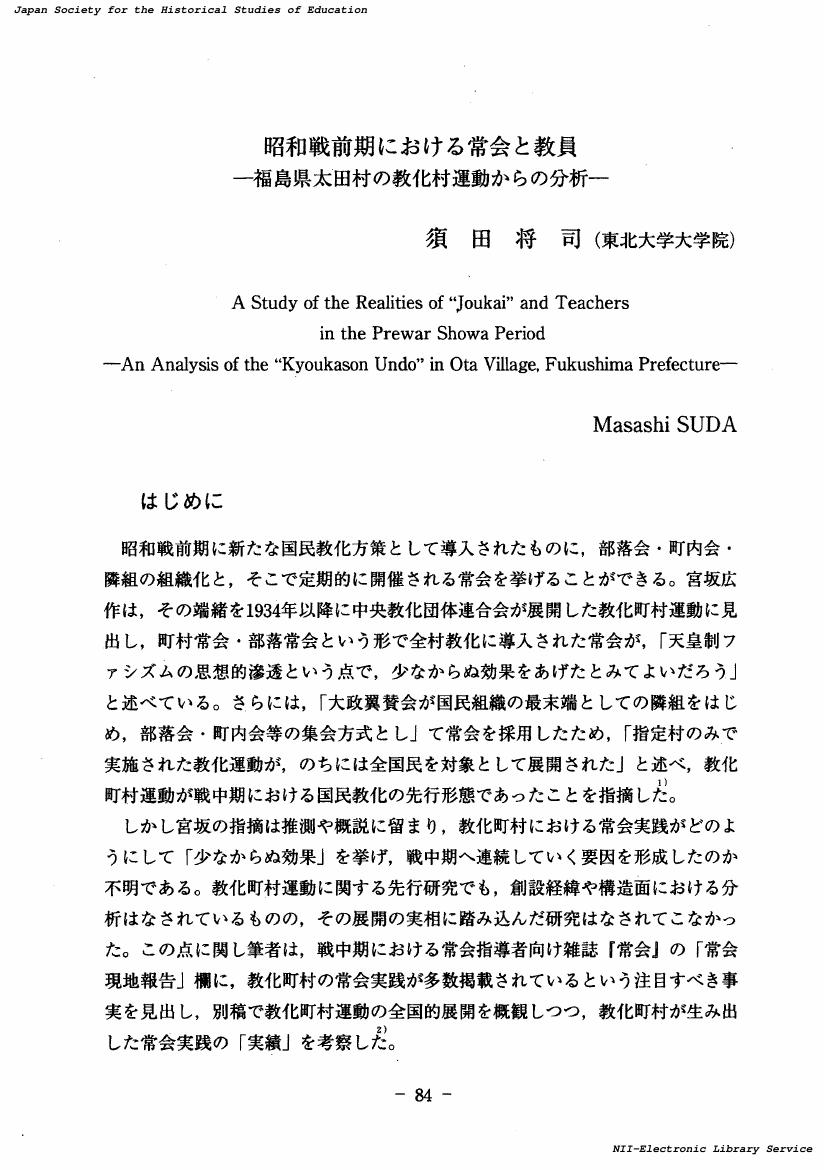7 0 0 0 OA 日中戦争期における「学校常会」論の広がり
- 著者
- 須田 将司
- 出版者
- 教育史学会
- 雑誌
- 日本の教育史学 (ISSN:03868982)
- 巻号頁・発行日
- vol.59, pp.032-044, 2016 (Released:2017-04-03)
- 参考文献数
- 16
During the Second Sino-Japanese war (1937-1941), there was an expansion of discourse and practice of “School Meetings” (gakko jokai), a term that here encompasses “Pupil Meetings” and “Children’s Neighborhood Groups.” This paper explores the trend of “School Meetings” discourse and its significance as a new method of drilling and training.Specifically, this paper analyzes the formation and development of this discourse and practice by focusing on the “Federation for Citizen Disciplinary Education” (Kokumin Kun’iku Renmei) and the “Japan Young Teachers Association” (Nihon Seinen Kyoshidan).In December, 1940, the “Federation for Citizen Disciplinary Education” held a workshop, inviting pioneering practitioners and theorists of “Morals Education” (hotoku kyoiku), thereby directly absorbing their know-how and theory. Thereafter, within the Federation, the practises that encourage children’s “virtues and merits” through “School Meetings,” and emphasize approach to the children’s inner side with “responsibility and compassion” were increased.As for, the “Japan Young Teachers Association” developed the theories and practices of “School Meetings” through connections with policy strategists. Their methods emphasized having a “cooperative heart” and practicing “self-reflection” as well as the importance of “public service” and “drilling.”“School Meetings” generated from the two “breeding grounds” both evoked “spontaneity” and “initiative” through “self-reflection” while removing self-assertion. This was inextricably linked to stifling feelings of children who were not committed themselves to drilling. The movement may be said to have exposed the limits of pedagogy.
1 0 0 0 OA 中央教化団体連合会刊・雑誌『常会』(1939-1944)の所蔵状況・目次一覧
- 著者
- 須田 将司
- 出版者
- 東洋大学
- 雑誌
- 東洋大学文学部紀要. 教育学科編 (ISSN:13474960)
- 巻号頁・発行日
- vol.44, pp.19-57,
1 0 0 0 OA 昭和戦前期における常会と教員 : 福島県太田村の教化村運動からの分析
- 著者
- 須田 将司
- 出版者
- 教育史学会
- 雑誌
- 日本の教育史学 (ISSN:03868982)
- 巻号頁・発行日
- vol.46, pp.84-103, 2003-10-01 (Released:2017-06-01)
1 0 0 0 OA 昭和戦前期「報徳教育」の錬成的・教育学的展開に関する実証的研究
1 0 0 0 IR 都道府県・旧植民地教育会雑誌 所蔵一覧
- 著者
- 梶山 雅史 須田 将司
- 出版者
- 東北大学大学院教育学研究科
- 雑誌
- 東北大学大学院教育学研究科研究年報 (ISSN:13465740)
- 巻号頁・発行日
- vol.54, no.2, pp.445-487, 2006-06
